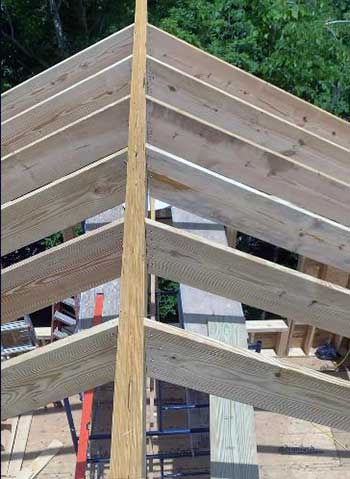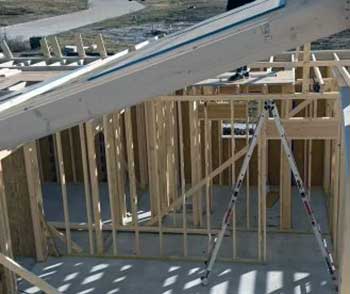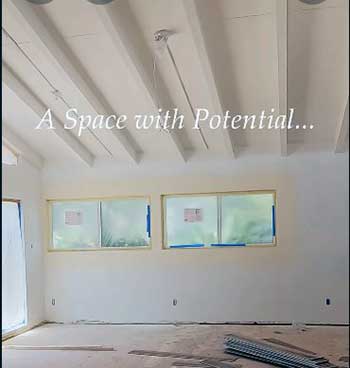As I explored the world of home design, I found myself captivated by the architectural charm of vaulted and sloped ceilings. These ceiling styles can transform a space, adding character and dimension. My goal here is to compare vaulted and sloped ceilings, highlighting their unique features, benefits, and drawbacks.
By sharing my insights and experiences, I aim to help you decide which ceiling style suits your home best, balancing aesthetics, functionality, and practicality.
A Brief Comparison Table
| Feature | Vaulted Ceiling | Sloped Ceiling |
|---|---|---|
| Definition | A ceiling that arches upward, creating a spacious, open feel. | A ceiling that slopes at an angle, often following the roofline. |
| Aesthetic Appeal | Dramatic, grand, and luxurious, enhancing room elegance. | Cozy, intimate, often modern or rustic, depending on design. |
| Space Perception | Increases perceived room size, making spaces feel airy. | Can make rooms feel smaller or cozier, depending on slope. |
| Construction Cost | Higher due to complex framing and materials. | Generally lower, simpler to construct. |
| Energy Efficiency | Less efficient, harder to heat/cool large spaces. | More efficient, smaller air volume to regulate. |
| Maintenance | Harder to access for repairs or cleaning. | Easier to maintain, more accessible surfaces. |
| Lighting Options | Allows for chandeliers, recessed lights, or skylights. | Suited for track lighting or wall-mounted fixtures. |
| Sound Acoustics | Echoes possible, may need soundproofing. | Better acoustics, less echo due to lower volume. |
My Experience With Vaulted Ceilings
I’ve always been drawn to the grandeur of vaulted ceilings. Walking into a room with a vaulted ceiling feels like stepping into a cathedral—there’s an undeniable sense of awe. In my friend’s living room, the vaulted ceiling soars to 14 feet, adorned with exposed beams that add rustic charm.
The space feels expansive, almost like it’s breathing. However, I noticed the room can feel chilly in winter, and the acoustics sometimes make conversations sound hollow. Cleaning those high corners? A nightmare. Yet, the visual impact is stunning, making it a focal point for gatherings.
In contrast, my own home has a sloped ceiling in the attic bedroom. It’s cozy, almost like a hug from the house itself. The slanted walls create a nook-like atmosphere, perfect for reading or relaxing. But I’ve bumped my head more times than I’d like to admit, and fitting furniture under the slope is a puzzle.
Both ceiling types have their charm, but they cater to different vibes and practicalities. My experiences taught me that choosing between them depends on your lifestyle and design goals.
Also read: My Thoughts on Quick-Step Laminate Flooring
Pros Of Vaulted Ceilings

- Visual Grandeur: Vaulted ceilings create a dramatic, open feel that makes any room appear larger and more luxurious, perfect for entertaining guests or showcasing architectural flair.
- Enhanced Lighting: The height allows for creative lighting options like chandeliers, pendant lights, or skylights, which can flood the space with natural or ambient light.
- Architectural Versatility: They suit various styles, from modern to rustic, especially when paired with exposed beams or decorative elements, adding character to the home.
- Increased Property Value: Homes with vaulted ceilings often attract buyers due to their premium aesthetic, potentially boosting resale value in competitive markets.
- Air Circulation: The extra height promotes better airflow, reducing stuffiness in rooms, especially in warmer climates where ventilation is key.
- Design Flexibility: The open space allows for bold decor choices, like large artwork or statement furniture, without overwhelming the room’s proportions.
- Sense of Space: Even smaller rooms feel expansive, making vaulted ceilings ideal for compact homes where maximizing perceived space is crucial.
Vaulted ceilings bring a sense of luxury that’s hard to beat. I’ve seen them transform bland spaces into showstoppers, especially in living rooms or master suites. The ability to incorporate skylights or tall windows adds a layer of brightness that elevates the mood. However, the grandeur comes with trade-offs, as I’ll explain later. For now, know that a vaulted ceiling can make your home feel like a masterpiece, provided you’re ready to embrace its unique demands.
Cons Of Vaulted Ceilings
- Higher Construction Costs: Building a vaulted ceiling requires complex framing, additional materials, and skilled labor, driving up renovation or construction expenses.
- Energy Inefficiency: The larger volume of air makes heating and cooling more challenging, leading to higher utility bills, especially in extreme climates.
- Maintenance Challenges: Cleaning or repairing high ceilings is difficult, often requiring specialized equipment or professional services, which adds to upkeep costs.
- Acoustic Issues: The open space can cause echoes, making conversations or media playback less clear unless soundproofing measures are implemented.
- Furniture Placement: Tall walls limit where you can place shelves or artwork, and some furniture may look out of scale in the expansive space.
- Lighting Costs: Installing and maintaining fixtures like chandeliers or recessed lighting in high ceilings can be expensive and labor-intensive.
- Feeling of Emptiness: In some cases, the vastness can make rooms feel impersonal or less cozy, especially for smaller households or intimate settings.
While vaulted ceilings are stunning, they’re not without flaws. I’ve noticed how they can make a room feel grand but also cold—both literally and figuratively. The energy bills in my friend’s vaulted-ceiling home are noticeably higher, and the echo during movie nights can be distracting. If you’re considering this style, weigh these drawbacks against the aesthetic appeal to ensure it aligns with your practical needs.
Maintenance Tips For Vaulted Ceilings

- Regular Dusting: Use a long pole or hire professionals to dust high corners and beams, preventing cobwebs and maintaining a polished look.
- Inspect for Leaks: Check for water stains or damage, especially near skylights, as vaulted ceilings are prone to roof-related issues due to their height.
- Clean Lighting Fixtures: Schedule annual cleaning of chandeliers or recessed lights to keep them shining brightly, using safe, extendable tools.
- Soundproofing Solutions: Add acoustic panels or rugs to reduce echoes, improving sound quality without compromising the aesthetic.
- Ventilation Maintenance: Ensure HVAC systems are serviced regularly to handle the larger air volume, maintaining comfort and efficiency.
- Seal Cracks: Inspect and seal any cracks in the ceiling or walls to prevent drafts and maintain energy efficiency over time.
- Professional Inspections: Hire experts biannually to assess structural integrity, especially for exposed beams or complex designs, to avoid costly repairs.
Maintaining a vaulted ceiling requires effort, but it’s worth it to preserve its beauty. I’ve learned that neglecting those high corners can lead to a dusty, neglected look, which diminishes the ceiling’s impact. Regular checks for leaks or cracks are crucial, especially in older homes. By staying proactive, you can keep your vaulted ceiling looking pristine and functioning well, ensuring it remains a highlight of your home for years.
My Experience With Sloped Ceilings
Living with a sloped ceiling has been a mix of charm and challenge. My attic bedroom, with its gentle slope, feels like a cozy retreat, perfect for unwinding after a long day. The angled walls add a unique character, making the space feel intimate and personal.
However, I’ve had to get creative with storage—standard wardrobes don’t fit, so I’ve opted for low-profile shelves. Lighting is another hurdle; overhead fixtures feel awkward, so I rely on floor lamps. Despite these quirks, the sloped ceiling gives my home a distinct personality that I’ve grown to love.
Comparing it to vaulted ceilings, sloped ceilings feel more grounded. They don’t demand attention like vaulted ceilings do, but they create a warm, inviting atmosphere.
I’ve found that sloped ceilings work best in smaller spaces or secondary rooms, like bedrooms or home offices, where coziness is a priority. Each style has its place, but my experience with sloped ceilings has shown me they’re ideal for those who value practicality and charm over grandeur.
Pros Of Sloped Ceilings

- Cost-Effective Construction: Sloped ceilings are simpler to build, often following the roofline, which reduces material and labor costs significantly.
- Energy Efficiency: The smaller air volume makes heating and cooling easier, leading to lower utility bills and a more sustainable home.
- Cozy Aesthetic: Sloped ceilings create an intimate, warm atmosphere, ideal for bedrooms, attics, or cozy living spaces.
- Easier Maintenance: Lower heights and accessible surfaces make cleaning and repairs straightforward, saving time and money.
- Flexible Lighting: Track lighting or wall-mounted fixtures work well, offering affordable and practical illumination options.
- Unique Design Appeal: The angled lines add architectural interest, blending well with modern, rustic, or minimalist styles.
- Better Acoustics: The compact space reduces echoes, making conversations and media playback clearer without additional soundproofing.
Sloped ceilings have a charm that’s hard to resist. In my home, the sloped ceiling in the bedroom creates a snug, almost cocoon-like feel that’s perfect for relaxation. They’re also a budget-friendly choice, which was a relief when I renovated my attic. The ease of maintenance and energy savings are big wins, especially for smaller households or those looking to keep costs down while still achieving a stylish look.
Cons Of Sloped Ceilings
- Limited Space: The angled design reduces usable headspace, making it challenging to stand upright or place tall furniture in some areas.
- Furniture Placement Issues: Standard furniture often doesn’t fit well, requiring custom or low-profile solutions, which can be costly.
- Lighting Challenges: Overhead lighting can be awkward, limiting options and requiring creative solutions like wall or floor lamps.
- Perceived Cramped Feel: In smaller rooms, the slope can make the space feel confined, especially for taller individuals.
- Storage Constraints: Built-in storage is harder to incorporate, as standard cabinets or shelves may not align with the angled walls.
- Lower Resale Appeal: Sloped ceilings may not appeal to all buyers, potentially limiting marketability compared to vaulted ceilings.
- Design Limitations: The slope restricts bold decor choices, like large artwork or tall shelving, which can feel stifling for some.
Sloped ceilings aren’t perfect. I’ve struggled with fitting furniture in my attic bedroom, and the low ceiling on one side can feel restrictive. For taller folks, this could be a dealbreaker. While they’re practical in many ways, the design constraints can frustrate those who love open, flexible spaces. Consider your needs carefully before opting for a sloped ceiling, as its cozy charm comes with compromises.
Maintenance Tips For Sloped Ceilings
- Dust Regularly: Use a standard duster to clean slanted surfaces, as they’re more accessible than vaulted ceilings, preventing buildup.
- Check for Mold: Inspect low areas near the roofline for moisture or mold, especially in humid climates, to avoid damage.
- Repaint Periodically: Refresh paint every few years to maintain a clean look, using a roller for easy application on sloped surfaces.
- Install Proper Lighting: Maintain track or wall lights, ensuring bulbs are replaced promptly to keep the space well-lit.
- Seal Joints: Check and seal joints where the ceiling meets walls to prevent drafts and improve energy efficiency.
- Ventilation Checks: Ensure vents are clear to maintain airflow, reducing the risk of moisture buildup in tight spaces.
- Monitor Structural Integrity: Inspect for cracks or shifts in the roofline, addressing issues early to avoid costly repairs.
Maintaining a sloped ceiling is relatively straightforward, which I appreciate in my own home. The accessible surfaces make dusting a breeze, and keeping an eye on potential mold spots is key in my humid climate. Regular upkeep keeps the ceiling looking fresh and ensures the cozy vibe remains intact. With minimal effort, a sloped ceiling can stay functional and charming for years.
Also read: Comparison of Rachio 3 And Orbit B-Hyve.
Frequently Asked Questions (FAQ)
A sloped ceiling follows the roofline at a consistent angle, creating a cozy, compact feel. A vaulted ceiling arches upward, often dramatically, to create a spacious, open atmosphere.
Vaulted ceilings can be costly to build, less energy-efficient, harder to maintain, and prone to echoes, which may affect comfort and practicality.
A vaulted ceiling is any ceiling that rises higher than a standard flat ceiling, typically arching or sloping upward to create a sense of height and grandeur.
Vaulted ceilings aren’t dated; they remain popular for their timeless elegance and ability to enhance modern or traditional home designs.
Conclusion: For Vaulted Ceiling Vs Sloped Ceiling
Choosing between a vaulted and sloped ceiling comes down to your priorities. If you crave drama, space, and a luxurious feel, a vaulted ceiling might be your pick, but be ready for higher costs and maintenance. If you prefer coziness, affordability, and practicality, a sloped ceiling could be perfect, though it limits space and design options. Reflect on your lifestyle—do you want a grand statement or a warm retreat? Both have unique charm, and I hope my insights help you find the ceiling that makes your home truly yours.
